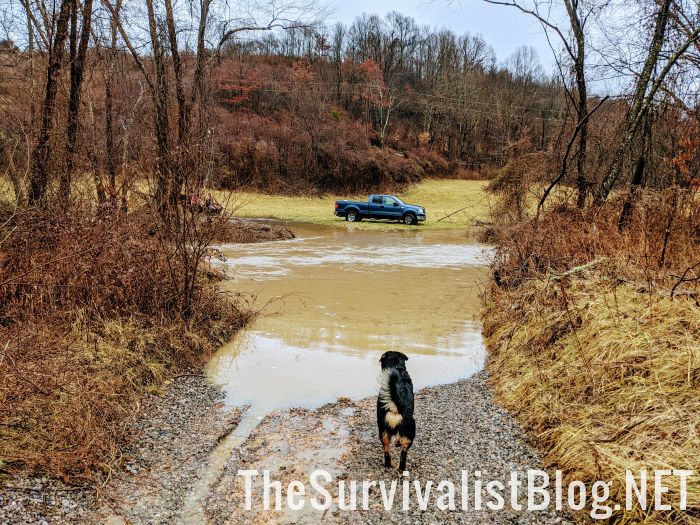What I Did To Prep This Week: February 28th 2021 – March 6th 2021


Hello Pack. We are really enjoying this lovely spring-like weather here on our survival retreat. Rain will come soon, as will more cold patches and likely a bit of snow. But, for now, we are thrilled to be back outside and working our land again.
All of the snow and ice melted and then we of course had a few days of rain, earlier this week. We knew exactly what was going to happen next – our creek flooded.
The feature photo shows what out misbehaving creek looked like after the water had receded enough to take a pickup truck through. You cannot tell from the photo, but the creek was still running incredibly fast even after we could get through it with a vehicle if it was a must.
In other preps this week, we canned potato soup, more chili, and finished processing blackberries we had picked and frozen – turning them into jam. Canned food has become a common Christmas present to loved ones that are not preppers, or who are elderly.
We put it in a big basket, often with a few pouches of long-term storage meals, tie a bow on it, and give the gift of shelf-stable food to folks we love.
I love springtime in the barnyard, it is so full of life and promise – and baby animal antics. Growing our goat herd further is definitely part of our survival plan for this year. I think that goats and ducks are the perfect livestock for preppers to keep.
Even though we have 56 acres and our own hayfields and equipment to provide year round feed for cattle, I still believe goats are the way to go if you are only going to keep one type of medium or large livestock.
Unlike hogs, which are easy keepers on a small acreage homestead or prepper retreat, goats provide not just meat, but milk.
Goats are far better at feeding themselves than either hogs or cattle. Our herd of miniature goats could make it through the winter eating dead leaves, brush, twigs, and acorns on our land if we could not use our farm equipment to bale hay – or if we lost the hayfield to flooding, fire, or man-made means.
We could keep a larger goat breed than the Nigerian, Pygmy, and Pygora goats (mini fiber goat breed) with the amount of land that we have, but these are all hardy breeds that are solid meat or milk producers.
The fiber sheared from the Pygora goats can be used to make yarn for knitting, crochet, or needle felting projects to make outerwear and blankets. Goat mohair sells for far more than wool from sheep, which generates more money to buy preps pre-SHTF.
Ducks produce larger and more eggs than chickens – many breeds produce at least a small amount of eggs even during the winter months. They are far more hot weather hardy than chickens.
As long as ducks have water to get into to cool off there is virtually no chance of them becoming ill or dying during periods of intense heat.
Ducks do not suffer from the same cold weather woes as chickens, frostbitten ducks are nearly unheard of on farms even in exceptionally cold climates.
This Week’s Questions:
- What do you do to help convince non-preppers you care about to become more self-reliant? Has it been easier to get loved ones to prepare because of the pandemic?
- What types of livestock do you consider a best for preppers to keep, and why?
- How do those of you that do not raise and grow their own food plan on preventing starvation during a long-term SHTF event that could last for years?
- What did you do to prep this week?
